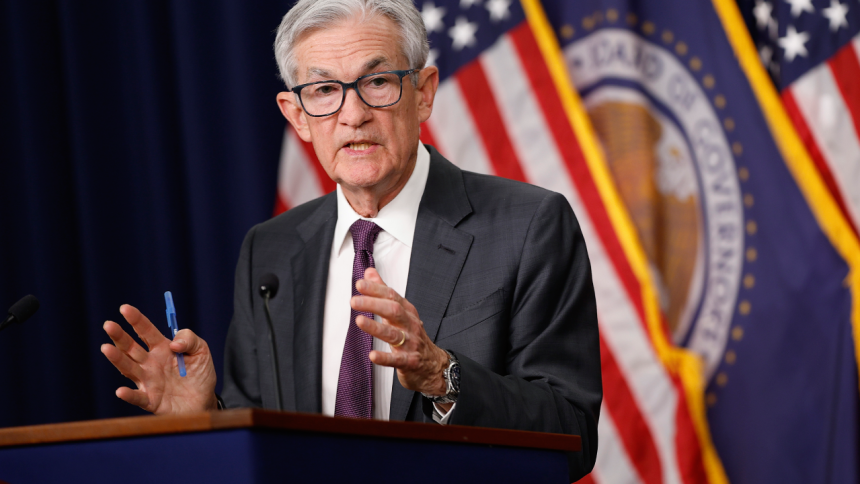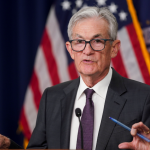The Federal Reserve left interest rates unchanged at its meeting today, but Fed Chair Jerome Powell highlighted the risks tariffs pose for the economy going forward.
Tariffs “tend to bring growth down; they tend to bring inflation up,” Powell said.
As a result of the Federal Open Market Committee’s (FOMC) decision today, its benchmark borrowing rate will stay in a target range of 4.25 to 4.5 percent.
Powell also said Trump’s latest tariffs are already driving some price increases: “We now have inflation coming in from an exogenous source,” Powell said, meaning an external source.
Uncertainty over Trump’s policies isn’t just rattling financial markets, businesses and consumers. It’s also impacting the U.S. central bank. With fears rising of an economic slowdown, the risk is that the next time the Fed cuts interest rates, it might be for more ‘bad’ reasons than ‘good.’
— Sarah Foster, Bankrate Principal U.S. Economy and Federal Reserve Reporter
In a statement, the FOMC said the economy has expanded and the labor market seems to be “solid,” but added that “uncertainty around the economic outlook has increased.”
In a time of economic uncertainty, consumers should consider focusing on what they can control, says Sarah Foster, Bankrate’s principal U.S. economy and Federal Reserve reporter. Pay down high-interest credit card debt and do what you can to build up your emergency fund, Foster says. See Bankrate’s live Fed meeting blog.
The Fed would much rather cut interest rates because inflation pressures are subsiding than because the economy is weakening. Depending on the path of economic data in the next few months, they may not have a choice.
— Greg McBride, CFA, Bankrate chief financial analyst
The news about tariffs fluctuates every day. Stay tuned to Bankrate’s latest updates to keep informed about what it means for you — and your money.
Current U.S. tariffs
- China: 20 percent on all imports on top of an already existing 10 percent tariff
- Canada: 25 percent on some goods, 10 percent on energy products
- Mexico: 25 percent on some imports
- European Union: 25 percent on steel and aluminum
President Donald Trump isn’t backing down from an all-out trade war, saying he’ll launch new tariffs come April 2.
“April 2 is a liberating day for our country, because we’re going to be getting back a lot of the wealth that we so foolishly gave up to other countries,” Trump said to reporters on Air Force One on Sunday.
Some of the new tariffs planned for April 2 will focus on specific sectors while others will be reciprocal, meaning the U.S. will impose the same tariff that a country has imposed on the U.S., Trump said.
“If they’re charging us, we’re charging them,” he said.
On top of reciprocal tariffs, Trump said he plans to levy new tariffs on cars, steel and aluminum. “We’re going to have some additional tariffs” on those products, he said.
Trump ratcheted up his economic threats against the United States’ trading partners last week, and Canada and the European Union quickly hit back with their own retaliatory levies.
Tariffs have been a key part of Trump’s bigger goal of shifting the burden of funding the U.S. government from American taxpayers to foreign sources. As part of that broader effort, he proposed creating an External Revenue Service, focused on collecting tariffs and other revenue from other countries. Here’s what the External Revenue Service could mean for you.
—Andrea Coombes, March 18, 2025
Canada and Mexico economies to be hit hard by tariffs
Trump’s relentless trade war is expected to hit Canada and Mexico especially hard, but the U.S. economy will suffer too, according to the latest economic forecast, published Monday, by the OECD, or Organization for Economic Cooperation and Development, a global policy group of 38 member countries.
- Mexico’s economy will likely shrink 1.3 percent this year and contract 0.6 percent in 2026, a sharp drop from an expected growth rate of 1.2 percent this year and 1.6 percent in 2026, from the OECD’s forecast in December.
- Canada’s economy is expected to grow 0.7 percent this year and next, down from an expected 2 percent growth rate each of those years in the OECD’s previous forecast.
- The U.S. economy will grow 2.2 percent this year and just 1.6 percent next year, down from a predicted 2.4 percent growth rate in 2025 and 2.1 percent in 2026, according to the OECD.
The current U.S. tariffs on Canada and Mexico generally are 25 percent, though products that fall under the United States-Mexico-Canada Agreement (USMCA) are exempt for now. Tariffs on goods from China are 20 percent, on top of an already existing 10 percent tariff.
In response to the U.S.’s tariffs, Canada slammed 25 percent tariffs on a variety of U.S. products, including candles, garden umbrellas and fishing rods on March 13. Here’s the complete list of U.S. products upon which Canada imposed a 25 percent tariff.
Trump threatens 200% tariff on European alcohol
March has been a particularly volatile month in the burgeoning trade war. On March 13, Trump said on his social media site Truth Social that he’d hit all champagne, wine and alcohol coming from the European Union with a 200 percent tariff, in response to the EU’s planned 50 percent tariff on U.S. whiskey.
On March 11, in response to the U.S. imposing 25 percent tariffs on steel and aluminum products from the European Union, the EU said it would impose counter tariffs on almost $30 billion worth of U.S. goods, starting next month.
EU tariffs will hit products “ranging from boats to bourbon to motorbikes,” the EU statement says.
Other targeted products include steel and aluminum items, textiles, home appliances, house tools, plastics and wood products. Agricultural products include poultry, beef, certain seafood, nuts, eggs, dairy, sugar and vegetables.
The EU announcement said its tariffs would start April 1 and be fully in place by April 13.
What are tariffs?
A tariff is essentially a tax on imported goods. Governments choose to levy tariffs for a variety of reasons, including protecting domestic industries and punishing other countries for their trade practices.
Trump has talked about tariffs as creating a protective “ring around the U.S. economy” that could bring jobs back. He’s also mentioned national security as a reason to institute tariffs — for example, to push other countries to better guard against drug trafficking.
Tariffs can be levied in different ways, but often they are a simple flat percentage cost that applies to the goods being imported.
Get expert guidance from a financial advisor
Trump’s tax policies could reshape the best strategies for managing your wealth or planning for retirement. Bankrate can match you with vetted financial advisors for free.
Find a financial advisor
Who pays tariffs?
Tariffs are paid by the company that imports the product. For example, U.S. tariffs on goods from Canada are paid by U.S. companies that import those goods. However, the company importing the product often passes the cost of tariffs along to the consumers who ultimately buy the product.
How much is passed along, though, depends on a variety of factors, such as competition in a specific industry, demand for the specific product and consumers’ preferences.
U.S. households will lose an estimated $2,700 to $3,400, on average, as a result of retaliatory tariffs, according to a recent analysis by the Yale Budget Lab. Before Trump announced plans for retaliatory tariffs scheduled for April 2, the Yale Budget Lab estimated that tariffs would cost U.S. households an average of $1,600 to $2,000.
Read the full article here
















